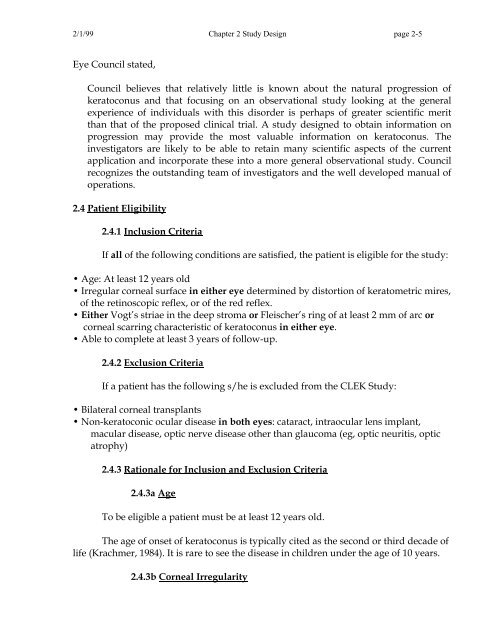OM t of c.iii - Vision Research Coordinating Center - Washington ...
OM t of c.iii - Vision Research Coordinating Center - Washington ...
OM t of c.iii - Vision Research Coordinating Center - Washington ...
You also want an ePaper? Increase the reach of your titles
YUMPU automatically turns print PDFs into web optimized ePapers that Google loves.
2/1/99 Chapter 2 Study Design page 2-5<br />
Eye Council stated,<br />
Council believes that relatively little is known about the natural progression <strong>of</strong><br />
keratoconus and that focusing on an observational study looking at the general<br />
experience <strong>of</strong> individuals with this disorder is perhaps <strong>of</strong> greater scientific merit<br />
than that <strong>of</strong> the proposed clinical trial. A study designed to obtain information on<br />
progression may provide the most valuable information on keratoconus. The<br />
investigators are likely to be able to retain many scientific aspects <strong>of</strong> the current<br />
application and incorporate these into a more general observational study. Council<br />
recognizes the outstanding team <strong>of</strong> investigators and the well developed manual <strong>of</strong><br />
operations.<br />
2.4 Patient Eligibility<br />
2.4.1 Inclusion Criteria<br />
If all <strong>of</strong> the following conditions are satisfied, the patient is eligible for the study:<br />
• Age: At least 12 years old<br />
• Irregular corneal surface in either eye determined by distortion <strong>of</strong> keratometric mires,<br />
<strong>of</strong> the retinoscopic reflex, or <strong>of</strong> the red reflex.<br />
• Either Vogt’s striae in the deep stroma or Fleischer’s ring <strong>of</strong> at least 2 mm <strong>of</strong> arc or<br />
corneal scarring characteristic <strong>of</strong> keratoconus in either eye.<br />
• Able to complete at least 3 years <strong>of</strong> follow-up.<br />
2.4.2 Exclusion Criteria<br />
If a patient has the following s/he is excluded from the CLEK Study:<br />
• Bilateral corneal transplants<br />
• Non-keratoconic ocular disease in both eyes: cataract, intraocular lens implant,<br />
macular disease, optic nerve disease other than glaucoma (eg, optic neuritis, optic<br />
atrophy)<br />
2.4.3 Rationale for Inclusion and Exclusion Criteria<br />
2.4.3a Age<br />
To be eligible a patient must be at least 12 years old.<br />
The age <strong>of</strong> onset <strong>of</strong> keratoconus is typically cited as the second or third decade <strong>of</strong><br />
life (Krachmer, 1984). It is rare to see the disease in children under the age <strong>of</strong> 10 years.<br />
2.4.3b Corneal Irregularity
















